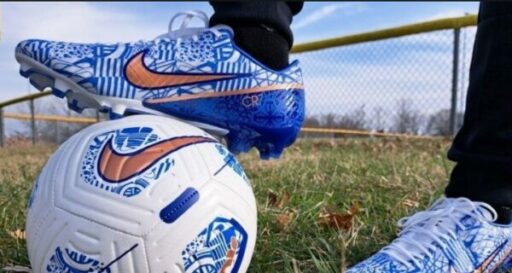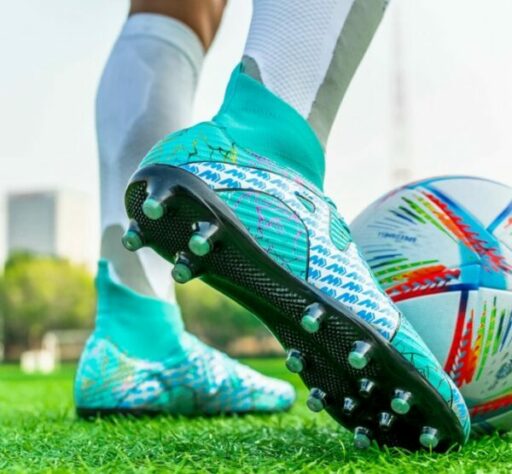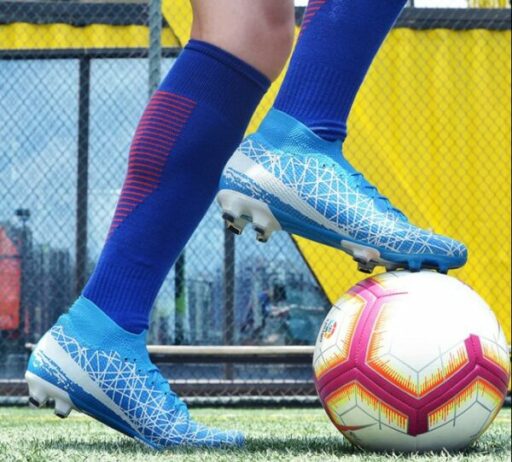Football and soccer are two of the most popular sports in the world. Millions of people across the globe play and watch these sports with great enthusiasm. One of the most important pieces of equipment for both football and soccer players is their footwear, commonly known as cleats. Cleats provide players with grip, stability, and protection on the field, making them an essential part of any player’s gear.
This article will explore the differences between football and soccer cleats. While both sports share similarities in cleat design, significant differences can impact a player’s performance on the field. By understanding these differences, you can make the right choice when selecting the appropriate cleats for your sport.
So, let’s dive into the various factors that differentiate football and soccer cleats, including design, playing surfaces, traction, protection, durability, cost, comfort, and style. By the end of this article, you’ll better understand how to choose the right cleats for your needs.
Design Differences

Design is an important factor when it comes to cleats. The materials used for construction, as well as the shape and placement of the cleat on the sole, can significantly impact a player’s performance.
Regarding materials, football cleats are typically made with leather or synthetic materials that provide durability and support for the foot. On the other hand, soccer cleats are often made with lighter materials, such as synthetic mesh, to allow for greater flexibility and speed.
Cleat shape and placement on the sole also differ between football and soccer cleats. Football cleats typically have studs or blades on the bottom of the sole, which are longer and broader than those found on soccer cleats. This design provides better traction and stability on grassy surfaces commonly used for football games.
Soccer cleats, on the other hand, have smaller and more numerous studs or blades on their soles. These cleats are designed to provide greater maneuverability on various playing surfaces, including artificial turf, hard ground, and soft grass.
In summary, while football and soccer cleats share certain design features, there are significant differences in materials, cleat shape, and placement on the sole. These differences reflect the unique needs of each sport and can impact a player’s ability to perform on the field.
Playing Surfaces
Playing surfaces also play a crucial role in determining the appropriate type of cleats to wear for football and soccer.
Football is predominantly played on natural grass fields, but some games are on artificial turf or other synthetic materials. In contrast, soccer can be played on various surfaces, including natural grass, artificial turf, clay, sand, and indoor courts.
The surface of the playing field impacts the type of traction needed from the cleat. For example, natural grass surfaces require longer and broader studs to provide better grip and stability. On the other hand, soccer cleats designed for artificial turf have shorter studs with a more significant number to prevent excessive strain on the player’s foot and reduce the risk of injury.
Studies show that improper footwear on the wrong playing surface increases athletes’ risk of lower extremity injuries. According to a study published in the Journal of Biomechanics, wearing inappropriate shoes on a given surface can increase the risk of serious knee, ankle, and foot injuries.
Therefore, players must wear the right type of cleats that match the playing surface to ensure proper traction, stability, and durability.
Traction

Traction is a critical aspect of football and soccer, affecting players’ ability to move quickly and make sharp turns on the field.
In football, cleat traction is designed to provide stability and grip on natural grass surfaces. The longer and broader studs found on football cleats are meant to penetrate the ground, providing better traction and preventing slipping on wet or muddy surfaces. On the other hand, soccer cleats have smaller and more numerous studs to allow for greater agility and quick movements.
The importance of proper traction in soccer must be addressed. In the sport, players’ movements often require sudden changes in direction and speed, which can put excessive stress on the foot and increase the risk of injury. Soccer cleats with appropriate traction significantly reduce the risk of slipping or sliding on the playing surface, allowing players to maintain stability and control during gameplay.
Examples of how traction affects gameplay include instances where a player may need to suddenly stop, change direction, or kick the ball with accuracy and power. With proper traction, the player may stay upright while running, potentially resulting in injury or poor performance.
Therefore, choosing cleats that match the playing surface and provide adequate traction for your sport to prevent accidents and improve your overall performance on the field is crucial.
Protection
While cleats are primarily designed to improve a player’s performance on the field, they also play an essential role in protecting players from injury.
In football and soccer, cleats serve as a layer of protection against potential injuries caused by collisions or slips. Football cleats provide extra support and padding around the ankle to prevent sprains or fractures. On the other hand, soccer cleats have thinner designs with increased mobility to allow for better control over the ball.
Improper use of cleats can cause injuries, however. Wearing shoes that don’t fit properly can lead to blisters, calluses, and other foot injuries. Moreover, using cleats intended for one sport on another playing surface can increase the risk of slipping, sliding, or twisting the ankle, leading to more serious injuries such as sprains, strains, and fractures.
Therefore, selecting cleats specifically designed for your sport and playing surface is important. Wearing the correct type of cleats provides adequate protection and helps reduce the risk of injury.
Durability

Durability is an essential factor in choosing the right cleats, as they are subjected to harsh conditions during gameplay, including wear and tear from the playing surface, temperature changes, and exposure to moisture.
Several factors affect cleat durability, including the quality of materials, frequency, and playing surface. Football cleats tend to be more durable due to the thicker materials used in construction. However, they can only wear out quickly if properly cared for. On the other hand, soccer cleats tend to be thinner and lighter, making them less durable but also allowing for greater flexibility and speed.
To maintain the longevity of your cleats, there are several tips you can follow. Firstly, always clean your cleats after each use, removing debris and dirt that can damage the material. Additionally, store your cleats in a dry, cool place, away from direct sunlight or heat sources that can cause them to warp or dry out. Alternating between pairs of cleats is also advisable to avoid overuse and allow time for them to dry out completely between uses.
In summary, while football cleats are generally more durable than soccer cleats due to their thicker construction, proper maintenance, and care are key to ensuring the longevity of either type of cleat.
Cost
When it comes to cleats, the cost is one of the most significant factors players consider when purchasing.
In general, football cleats tend to be more expensive than soccer cleats. The price range for football cleats can vary widely, with high-end models costing several hundred dollars and budget options available for around $50. On the other hand, soccer cleats typically cost less, ranging from $30 for basic models to around $200 for top-of-the-line options.
However, it’s essential to consider the quality vs. cost ratio when purchasing cleats. While it may be tempting to opt for cheaper, low-quality cleats, they are less durable. They may not provide adequate support or protection, leading to potential injuries and poorer performance on the field. On the other hand, investing in high-quality cleats can improve your performance and reduce the risk of injuries.
Several factors influence the price of cleats, including the materials used, design features, and brand reputation. High-end cleats often incorporate innovative technology, such as lightweight materials and advanced traction systems, which can increase prices. Additionally, popular brands endorsed by professional athletes may have a higher price tag due to their marketability.
In summary, while football cleats are more expensive than soccer cleats, the quality of the cleat should be prioritized over cost. Investing in a high-quality pair of cleats can improve performance, protect against injury, and ultimately save money in the long run by reducing the need for frequent replacements.
Comfort
Comfort is a critical factor when selecting the right cleats for your sport. Comfortable cleats allow for better foot control and reduce the risk of blisters, calluses, or other foot injuries.
Features that make cleats comfortable include:
- The quality of materials used.
- Cushioning around the heel and ankle.
- The shoe’s overall fit.
High-quality materials such as leather or synthetic mesh can provide both durability and comfort while cushioning around the heel and ankle can reduce pressure points and improve shock absorption.
Regarding comfort level, football, and soccer cleats differ slightly due to the unique demands of each sport. Football cleats often have more padding and support around the ankle to protect against the impact on the field, making them feel bulkier than soccer cleats. Soccer cleats tend to be lighter, with less padding and thinner materials, allowing for greater flexibility and mobility.
It’s important to note that every player has different preferences regarding comfort level, so trying on several pairs of cleats before making a final decision is essential. Properly fitting cleats should feel snug but not too tight, with enough room for your toes to move freely.
Overall, comfort is crucial in selecting the right cleats for your sport. Whether playing football or soccer, choosing cleats that provide support and proper fit will ensure a more enjoyable, less painful playing experience.
Style
Style is often a consideration when choosing cleats, as players want to look good and feel confident on the field. While style should not be the primary factor in selecting cleats, it can still play a role in decision-making.
Football and soccer cleats are available in various styles, colors, patterns, and designs. Some players prefer bold, eye-catching styles, while others opt for more understated, classic looks. Ultimately, the style of your cleats should complement your personal style while also meeting performance needs.
Popular brands of football cleats include Nike, Adidas, Under Armour, and Puma. Each brand offers a variety of models with unique features designed for different playing styles and skill levels. Soccer cleat brands include the same plus several other brands specific to soccer, such as Diadora, Umbro, and Lotto.
Endorsements from professional athletes can significantly impact sales, with many players opting for cleats worn by their favorite players. For example, Cristiano Ronaldo endorses the Nike Mercurial line of soccer cleats, which has led to increased popularity and sales of that particular model.
While style and endorsements can influence sales, it’s important to prioritize the quality and functionality of the cleat over aesthetics. At the end of the day, the right cleat should provide support, protection, and traction for your sport while also meeting your personal style preferences.
Conclusion
In conclusion, choosing the right cleats is essential for football and soccer players. Football and soccer cleats have several key differences, including design, playing surfaces, traction, protection, durability, cost, comfort, and style. By understanding these differences and considering your individual needs as a player, you can make an informed decision when selecting the appropriate cleats for your sport.
When choosing cleats, it’s important to consider factors such as the playing surface, necessary traction, protection needed, durability, comfort level, and style preference. Additionally, investing in high-quality cleats may be more expensive but tend to provide a better performance, reduced risk of injury, and longevity.
Some final recommendations for choosing the right cleats include trying on several pairs before deciding, finding the best balance between support and flexibility, and selecting a pair that fits properly with enough room for your toes to move freely.
In summary, the right pair of cleats can greatly enhance your performance and protect against injury on the field, so take the time to carefully consider your options and choose the best cleats.
